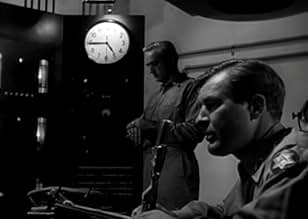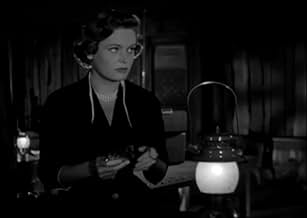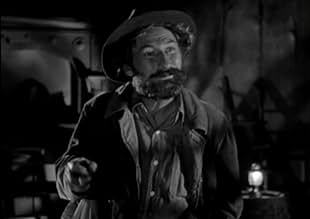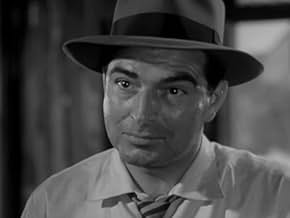VALUTAZIONE IMDb
6,8/10
2236
LA TUA VALUTAZIONE
Aggiungi una trama nella tua linguaThree hardened criminals take hostages and hide in a Nevada mining ghost town, knowing that an atom bomb is scheduled to be tested there the next morning.Three hardened criminals take hostages and hide in a Nevada mining ghost town, knowing that an atom bomb is scheduled to be tested there the next morning.Three hardened criminals take hostages and hide in a Nevada mining ghost town, knowing that an atom bomb is scheduled to be tested there the next morning.
- Regia
- Sceneggiatura
- Star
Frank DeKova
- Dummy
- (as Frank de Kova)
Fred Aldrich
- Hunter Driver
- (non citato nei titoli originali)
Benny Burt
- Hunter
- (non citato nei titoli originali)
John Cliff
- Gas Station Attendant
- (non citato nei titoli originali)
Dick Crockett
- Air Force Helicopter Pilot
- (non citato nei titoli originali)
John Diggs
- Colonel at Control Station
- (non citato nei titoli originali)
William Forrest
- Colonel Wright
- (non citato nei titoli originali)
Fred Graham
- A.F. Captain in Helicopter
- (non citato nei titoli originali)
Karen Hale
- Nurse
- (non citato nei titoli originali)
Clark Howat
- Lieutenant at Control Station
- (non citato nei titoli originali)
Recensioni in evidenza
Small gem of a movie filled with faces you know. Glad I stumbled upon it today.
The genre of film-noir can be divided into three eras - generally speaking: the classic era (1940-1945), the postwar era (1945-1953) and the Cold War era (1953-1958-60?). Film-noir was always a genre about fear, moral complexity and desperation. When the WWII film-noir exuded postwar disillusions; the concrete war was over but it was still going on on social level: in our minds and in the society. What genre would fit more perfectly to the ages of paranoia and fear than the genre of them, film-noir. To my mind Split Second is the first Cold War film-noir - a statement which one could argue about because in the same year 1953 Samuel Fuller made a film-noir about paranoia and the fear of communism Pickup on South Street (1953).
Dick Powell was the star of the Hollywood musicals in 1930's. In 1940's he tried to change his image from a singing dancer to the new bad boy of Hollywood. In 1944 Edward Dmytryk directed Murder, My Sweet based on a novel by Raymond Chandler and casted Dick Powell to play Philip Marlowe - the greatest private eye of film-noir, but the performance by Powell is often left in the shadows of Humphrey Bogart's Philip Marlowe interpretation in The Big Sleep (1946). After the war Dick Powell had some experience from film-noir and he chose to try directing as well. Split Second was his debut of the six films he directed and I think he succeed quite well in it.
1950's was the age when the government of the United States made a lot of nuclear weapon experiments: in the deserts of US and in the famous Bikini island. This offered a chance to make a thriller around these kind of events and Split Second represents the attempt of transforming film-noir from its usual big city milieus to a deserted town in Nevada under the fear of the war. Three men have just escaped from prison, unaware of the nuclear experiments of the government. Soon the group of three takes a few hostages in result of getting a doctor because one of the escapees is injured. As time goes on in the deserted town the hostages start to lose their morality and the time before the explosion is running out.
The aesthetics of film-noir were often related to big cities like New York or Los Angeles and exotic milieus were always part of the genre but usually they meant bars in Chinatown, motels of Arabia or the cold streets of Shanghai. In 1950's many tried to transform film-noir to new milieus: to snowy conditions (On Dangerous Ground), to the narrow halls of a train (The Narrow Margin) and to the back seats of a car (The Hitch-Hiker). To me Split Second represents the attempt of transforming film-noir to deserted towns, which The Hitch-Hiker (1953) did as well, but Split Second also tried to bring film-noir to the Atomic Age.
There's no question whether this is a high quality noir or a B-class film. The latter can be seen in its conventional direction, low budget and it has got a great number of unknown actors. But the way I see it Split Second is alongside with all the b-class Mitchum films one of the bests. It's a great example of Cold War films and how the Atomic Age affected cinema. It's an entertaining thriller but also a fine survey of the disappearance of morality.
Dick Powell was the star of the Hollywood musicals in 1930's. In 1940's he tried to change his image from a singing dancer to the new bad boy of Hollywood. In 1944 Edward Dmytryk directed Murder, My Sweet based on a novel by Raymond Chandler and casted Dick Powell to play Philip Marlowe - the greatest private eye of film-noir, but the performance by Powell is often left in the shadows of Humphrey Bogart's Philip Marlowe interpretation in The Big Sleep (1946). After the war Dick Powell had some experience from film-noir and he chose to try directing as well. Split Second was his debut of the six films he directed and I think he succeed quite well in it.
1950's was the age when the government of the United States made a lot of nuclear weapon experiments: in the deserts of US and in the famous Bikini island. This offered a chance to make a thriller around these kind of events and Split Second represents the attempt of transforming film-noir from its usual big city milieus to a deserted town in Nevada under the fear of the war. Three men have just escaped from prison, unaware of the nuclear experiments of the government. Soon the group of three takes a few hostages in result of getting a doctor because one of the escapees is injured. As time goes on in the deserted town the hostages start to lose their morality and the time before the explosion is running out.
The aesthetics of film-noir were often related to big cities like New York or Los Angeles and exotic milieus were always part of the genre but usually they meant bars in Chinatown, motels of Arabia or the cold streets of Shanghai. In 1950's many tried to transform film-noir to new milieus: to snowy conditions (On Dangerous Ground), to the narrow halls of a train (The Narrow Margin) and to the back seats of a car (The Hitch-Hiker). To me Split Second represents the attempt of transforming film-noir to deserted towns, which The Hitch-Hiker (1953) did as well, but Split Second also tried to bring film-noir to the Atomic Age.
There's no question whether this is a high quality noir or a B-class film. The latter can be seen in its conventional direction, low budget and it has got a great number of unknown actors. But the way I see it Split Second is alongside with all the b-class Mitchum films one of the bests. It's a great example of Cold War films and how the Atomic Age affected cinema. It's an entertaining thriller but also a fine survey of the disappearance of morality.
My understanding of this motion picture is much different. My family owned the gas station and inn that appears in the picture. I have many memories of director Powell flying around in a rather unusual aircraft for the time, a helicopter. Being very young, I didn't have much interaction with the adults as they wanted to imbibe after the shootings for the day but I do recall having to be silent and not play in the front of the business. This is truly a unique story line for the early '50s. The cold war was in full swing so any movie about this subject captured audience attention. I have since purchased video tapes for members of my family. Excelent example of the A-Bomb era genre. Others: The Day The Earth Stood Still, Godzilla.
A cultish favourite that is often listed for festivals of noir cinema, this work is less noirish than it is a clear example from the Theatre of Paranoia, as Dick Powell's directorial debut melds nuclear explosion fears with a harrowing hostage taking by two escaped convicts fleeing from a Nevada prison. The escapees, Sam (Stephen McNally) and Bart (Paul Kelly) helped by mute accomplice Dummy (Frank DeKova), take refuge in an abandoned mining town, Yucca Flats, along with six prisoners they acquire during their flight, despite their awareness that the desert ghost town is within a nuclear test site where, in 12 hours, a combined military force is going to explode a tower bomb armed with high grade scissile plutonium. Sam believes that he and his two cohorts will be able to evade a protective army encirclement and escape prior to the blast, but the uncertain fate of their hapless hostages becomes the oarlock for the film's atmosphere of foreboding, with one of the captives, played by Keith Andes, being a Las Vegas newspaper reporter who has full knowledge of the detonation schedule, having attended planning meetings during which the event's timetable has been established. For Powell's initial effort as a director of features, he selects a restricted environment, essentially one large room, as setting for his limited cast of featured players, with the bomb becoming an additional sinister character. Following initial lead-in scenes, including interlaced footage of actual soldiers and military technicians, a stage mise-en-scène is established to advance an atmosphere of suspense. Unfortunately, Powell's inexperience with ensemble work is in evidence here, as the players generally simply take turns with their readings, although a good deal of the dialogue is trenchant. The villainous trio is the most interesting of the cast, with Kelly taking the acting palm for his strong yet low-keyed turn as one who was severely wounded during the prison break, and Richard Egan is convincing as a physician gulled into performing surgery upon Bart, while on the distaff side talented Jan Sterling handily outperforms the histrionic Alexis Smith. Shot in California's Mojave Desert, this work benefits from R.K.O.s master cinematographer with black and white stock, Nick Musuraca, and there is an appropriately dramatic score from Roy Webb. A nearly fatal flaw is the artless attitude toward the dangerous effects of atomic radiation, although it must be conceded that applicable information available to the general public was scanty at the time of the film's production.
Dick Powell directed "Split Second," a B movie starring Stephen McNally, Jan Sterling, Alexis Smith, Richard Egan, and Keith Andes, about prisoners and their hostages at an atomic test site. McNally, meaner than dirt, escapes from prison with two cronies, one of whom has been badly wounded. At a gas station, they carjack Alexis Smith and her boyfriend. Before long, they have four hostages: Keith Andes, who plays a reporter, and Jan Sterling, who hitched a ride with him. They all wind up on an atomic bomb test site, and there's a test set for the next day. Since Smith's husband is a doctor, McNally calls him and threatens him with Smith's life so he will come and save the wounded escapee.
Seen with modern eyes, the friendship between McNally and his injured pal is something to behold. McNally is a cruel tough guy who becomes gentle when speaking to his friend, and he's determined not to leave him behind. Hmm...Smith plays a desperate, selfish society woman who will do anything - underline anything - to get McNally to take her along when he leaves, and in fact, they have a protracted time together in another room. She's a real piece of work. Richard Egan is her husband, who arrives to help the wounded prisoner.
Keith Andes was a handsome man whose major career was in television, and his beautiful singing voice and masculine presence brought him Broadway success as well, particularly costarring with Lucille Ball in "Wildcat." He does a good job here, as does Jan Sterling - they are two people caught in bad circumstances who happen to fall in love along the way. McNally is as nasty as they come - another fine performance of a low-life.
Dick Powell's direction has a sure hand, and the tension mounts as the film continues. A very good B movie, but not really noir as has been suggested.
Seen with modern eyes, the friendship between McNally and his injured pal is something to behold. McNally is a cruel tough guy who becomes gentle when speaking to his friend, and he's determined not to leave him behind. Hmm...Smith plays a desperate, selfish society woman who will do anything - underline anything - to get McNally to take her along when he leaves, and in fact, they have a protracted time together in another room. She's a real piece of work. Richard Egan is her husband, who arrives to help the wounded prisoner.
Keith Andes was a handsome man whose major career was in television, and his beautiful singing voice and masculine presence brought him Broadway success as well, particularly costarring with Lucille Ball in "Wildcat." He does a good job here, as does Jan Sterling - they are two people caught in bad circumstances who happen to fall in love along the way. McNally is as nasty as they come - another fine performance of a low-life.
Dick Powell's direction has a sure hand, and the tension mounts as the film continues. A very good B movie, but not really noir as has been suggested.
Lo sapevi?
- QuizThe escaped convict Bart Moore is played by Paul Kelly, who himself spent 25 months during the late 1920s in California's San Quentin State Prison. He was convicted of manslaughter for the beating death of actor Ray Raymond, the first husband of actress Dorothy Mackaye, who was having an affair with Kelly and would later marry him. Kelly's next film was Duffy of San Quentin (1954), where he plays the title role - the warden of the prison where he himself did time.
- BlooperConsidering the level of security around the test site, including the number of roadblocks set up to keep people away, it should have been impossible for Dr. Garven to drive into the ghost town seemingly unimpeded.
- Citazioni
Larry Fleming: [referring to Dottie's mother] Six husbands, and you're still working on your first.
Dorothy 'Dottie' Vail: Mother used up all the men we knew.
- ConnessioniFeatured in Noir Alley: Split Second (2017)
I più visti
Accedi per valutare e creare un elenco di titoli salvati per ottenere consigli personalizzati
- How long is Split Second?Powered by Alexa
Dettagli
- Tempo di esecuzione
- 1h 25min(85 min)
- Colore
- Proporzioni
- 1.37 : 1
Contribuisci a questa pagina
Suggerisci una modifica o aggiungi i contenuti mancanti




































